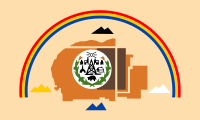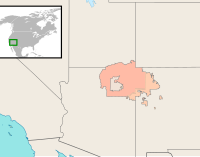
The flags of the U.S. states, territories, and the District of Columbia exhibit a variety of regional influences and local histories, as well as different styles and design principles. Modern U.S. state flags date from the turn of the 20th century, when states considered distinctive symbols for the 1893 World's Columbian Exposition in Chicago, Illinois. Most U.S. state flags were designed and adopted between 1893 and World War I.

The flag of Minnesota is the state flag of the U.S. state of Minnesota. Its design features a modified version of the seal of Minnesota emblazoned on a blue field. The flag's first version was adopted in 1893, in advance of the state's mounting an exhibition at the 1893 Chicago World's Fair. It was significantly revised in 1957 and received a minor update in 1983.

The official flag of New Mexico, a subnational polity of the United States, consists of a red sun symbol of the Zia people on a field of gold (yellow). It was officially adopted in 1925 to highlight the state's Native American and Hispano heritage: It combines a symbol of the Puebloan people, who have ancient roots in the state, with the colors of the flag of Spain, which established and ruled Nuevo México for over two and a half centuries.

The flag of Oklahoma, also known as the Oklahoma flag, is a rectangular field of sky blue on which is placed an Osage war shield with six crosses and seven pendant eagle feathers above the word 'Oklahoma' in white. Superimposed onto the crosses of the war shield is a calumet and an olive branch.

The North American Vexillological Association (NAVA) is a membership organization devoted to vexillology, the study of flags. It was founded in 1967 by American vexillologist Whitney Smith, and others. Its membership of 1,100+ comprises flag scholars, enthusiasts, designers, collectors, conservators, educators, merchants, manufacturers, historians, and hobbyists from most states and provinces of the United States and Canada, and more than 30 other countries.

The flag of Indianapolis has a dark blue field with a white five-pointed star pointing upwards in the center. Around the star is a circular field in red. Surrounding the red field is a white ring, from which extend four white stripes from top to bottom and from hoist to fly, thus creating four equal quadrants in the field. The stripes are about one-seventh the width of the flag, with the white ring the same width as the stripes. The diameter of the red circle is about two-ninths the width of the flag.

The city flag of Los Angeles consists of a background of three notched stripes of green, gold and red. The flag was designed by Roy E. Silent and E.S. Jones in 1931 for the Los Angeles sesquicentennial from 1781.

The city flag of Portland, Oregon, consists of a green field on which is placed a white four-pointed star from which radiate blue stripes, each bordered by L-shaped yellow elements (esquarres). Narrow white fimbriations separate the blue and yellow elements from each other and from the green background. The official ordinance specifies a height of 3 feet and a length of 5 feet.
The flags of the provinces of the Philippines are the vexillological devices used by various provincial-level local government units (LGUs) of the country.
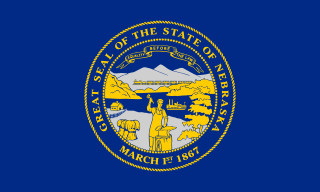
The flag of the state of Nebraska is a blue rectangular cloth charged with a variation of the Nebraskan state seal. The current design was commissioned in 1925, when the Nebraska legislature passed a bill stating that the flag would consist of the state seal in gold and silver on a field of blue.

The flag of Phoenix, Arizona, is the official municipal flag of Phoenix, Arizona. Its current design is a maroon field with a white phoenix emblem in the center. The design is the second in the city's history and has been in place since 1990, replacing a flag that was adopted in 1921.

The flag of the Hopi Tribe is used by the Native American Hopi Tribe of Arizona in the United States who live on the Hopi Reservation. The flag is a vertical tricolour of turquoise, white, and yellow, with the Hopi symbol in the middle. The flag is accompanied by a red fringe. The Hopi reservation is surrounded by the Navajo Nation.

The municipal flag of Provo, Utah, United States, features the city's logo on a light blue field. It was adopted on January 6, 2015, after a multi-year debate to replace the previous one. The former flag, adopted in 1989, was ridiculed in particular for its perceived ugliness and its similarity to the Centrum logo, and was voted one of the worst American city flags by the North American Vexillological Association (NAVA).
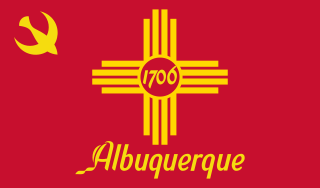
The flag of Albuquerque, New Mexico, is the official municipal flag of Albuquerque, New Mexico. The design is a red field with yellow elements.

The flag of San Jose is the official municipal flag of San Jose, California. The current design, a triband of gold on top, white in the middle, and blue on the bottom with the city's official seal in the center, has been the official flag since 1984.

The flag of Charlotte is the official municipal flag of Charlotte, North Carolina. The official flag was adopted in 1929 and consists of a white saltire on a blue field, with the city seal in the center. A secondary flag, with a green field and a white crown in the center, was introduced in 1985 and is primarily used at city government buildings. Charlotte is one of the few places to have two official flags with equal status. The government of Mecklenburg County, while having its own flag, has made use of the 1985 flag at official events.

The flag of Columbus is the official municipal flag of Columbus, Ohio. Its current design is a yellow, white, red vertical triband with the city seal on a blue field. Officially, the flag was adopted in 1929, although it is unknown if the flag was ever flown when it was first adopted.

The flag of El Paso is the official municipal flag of El Paso, Texas. The current design, an augmentation of El Paso's seal in the center of a dark blue field, has been in place since 1962.

The flag of South Bend, Indiana, was adopted by the city council during the mayorship of Pete Buttigieg on April 25, 2016. It is a field of white and yellow separated by a two blue curved lines with a white line between them and a red six-pointed star in the upper left corner.
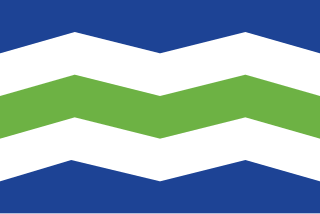
The flag of Burlington, Vermont was adopted by the Burlington city council on November 27, 2017 during the mayorship of Miro Weinberger. It is five horizontal, zig-zag stripes of blue, white, green, white, and blue.
